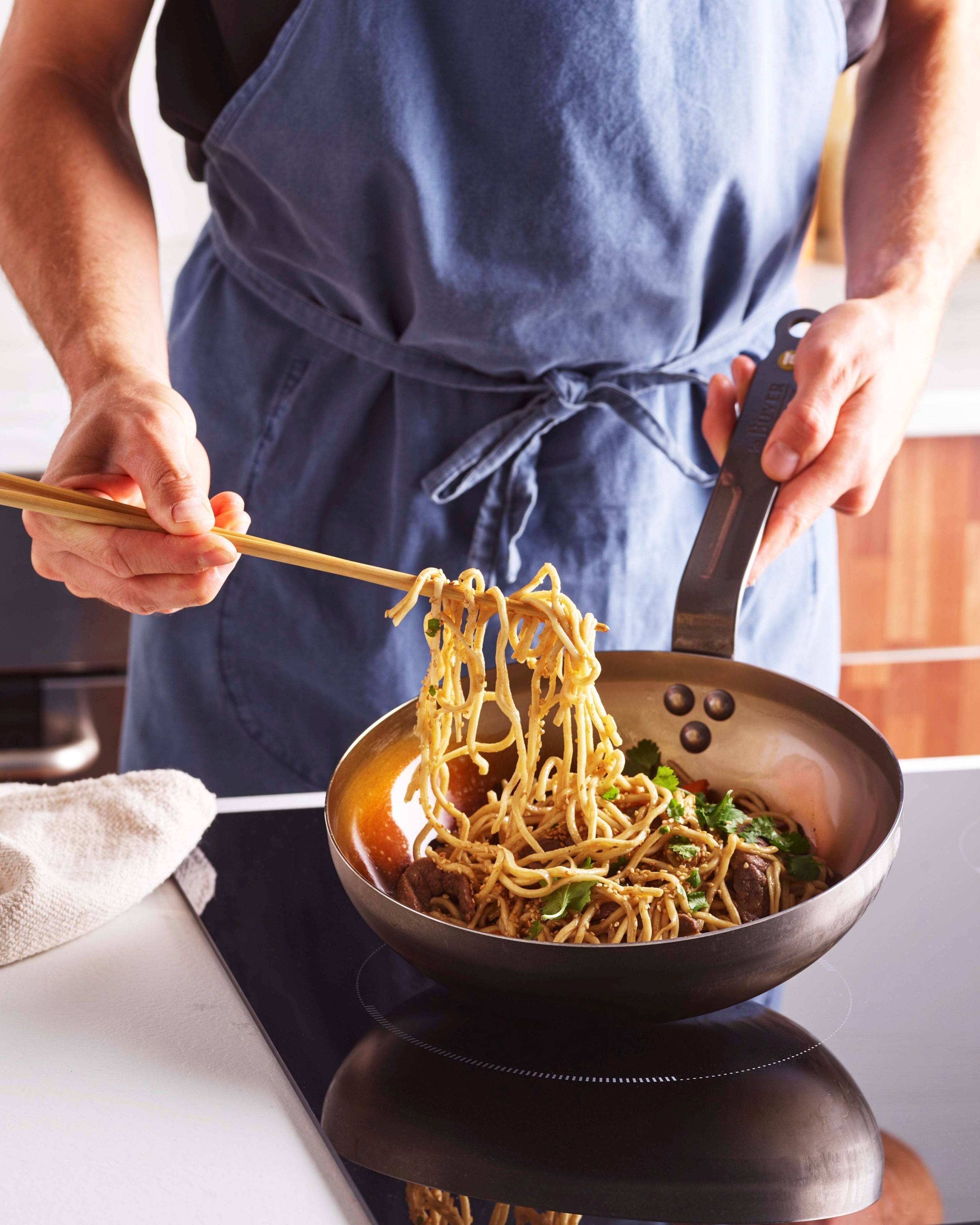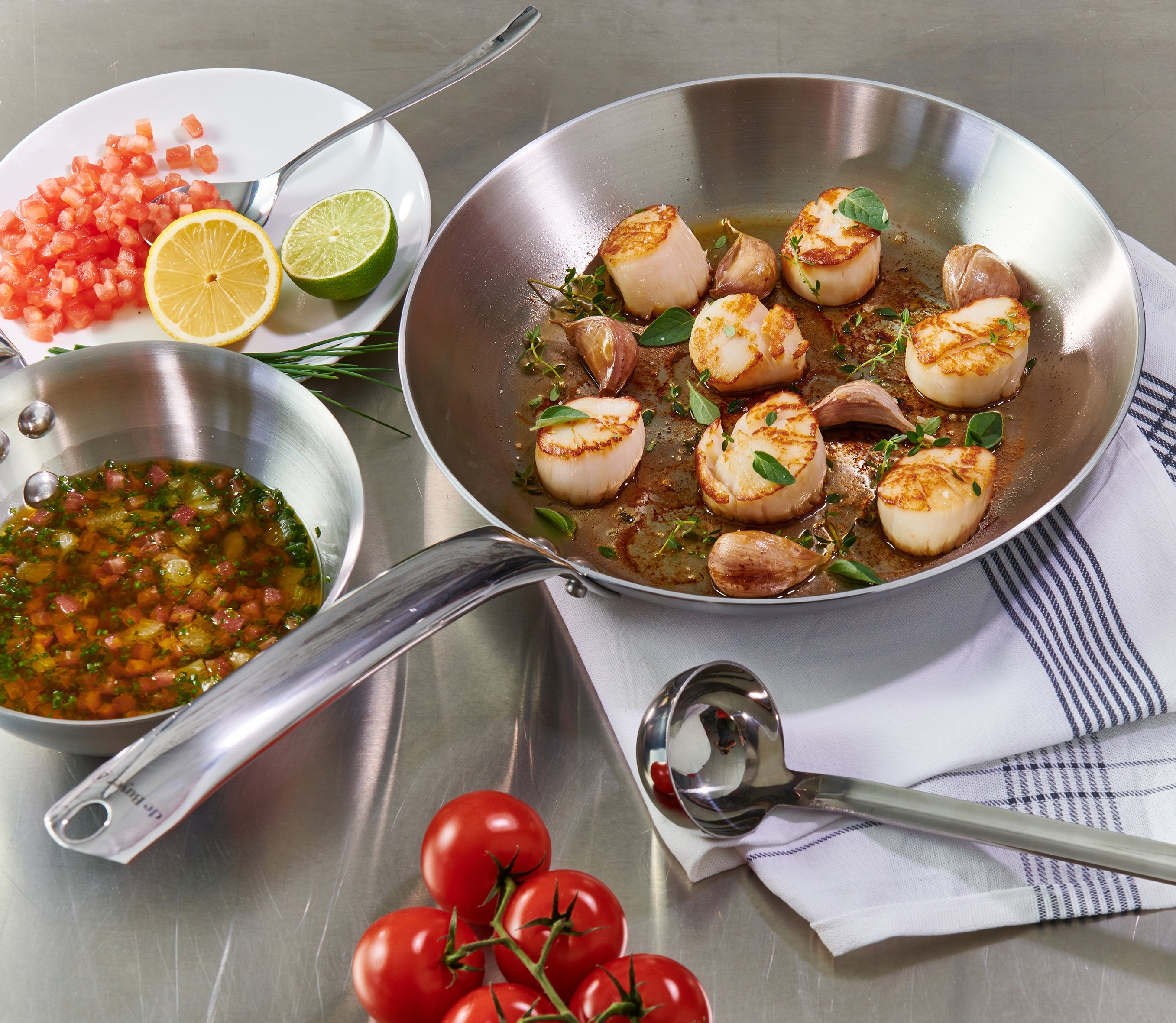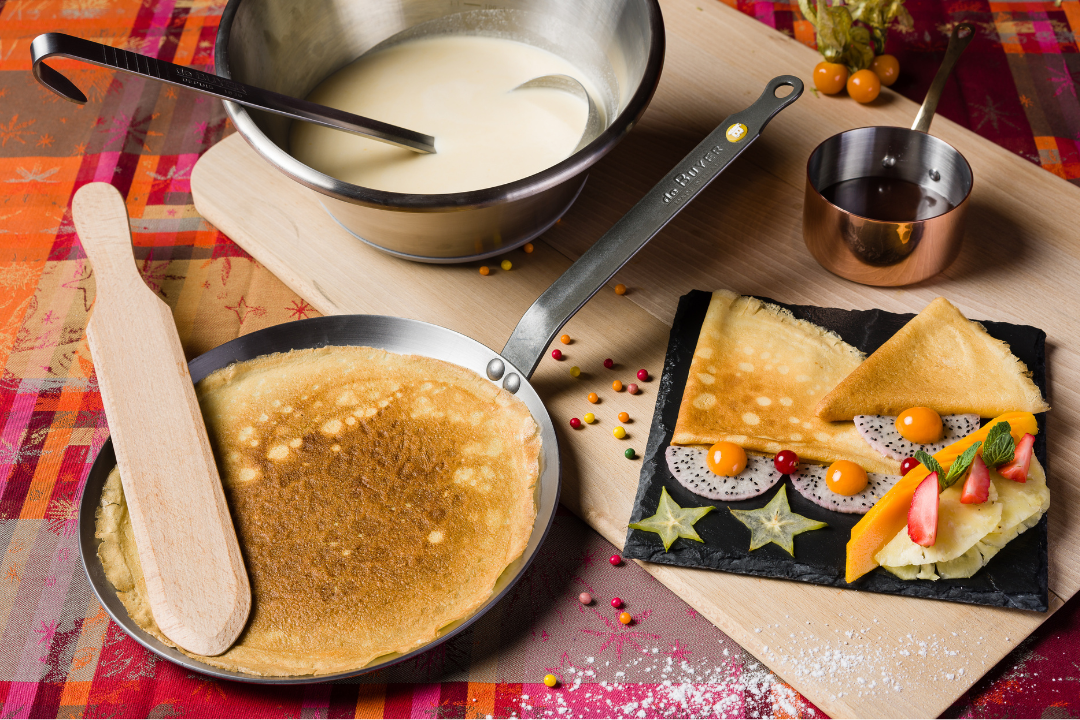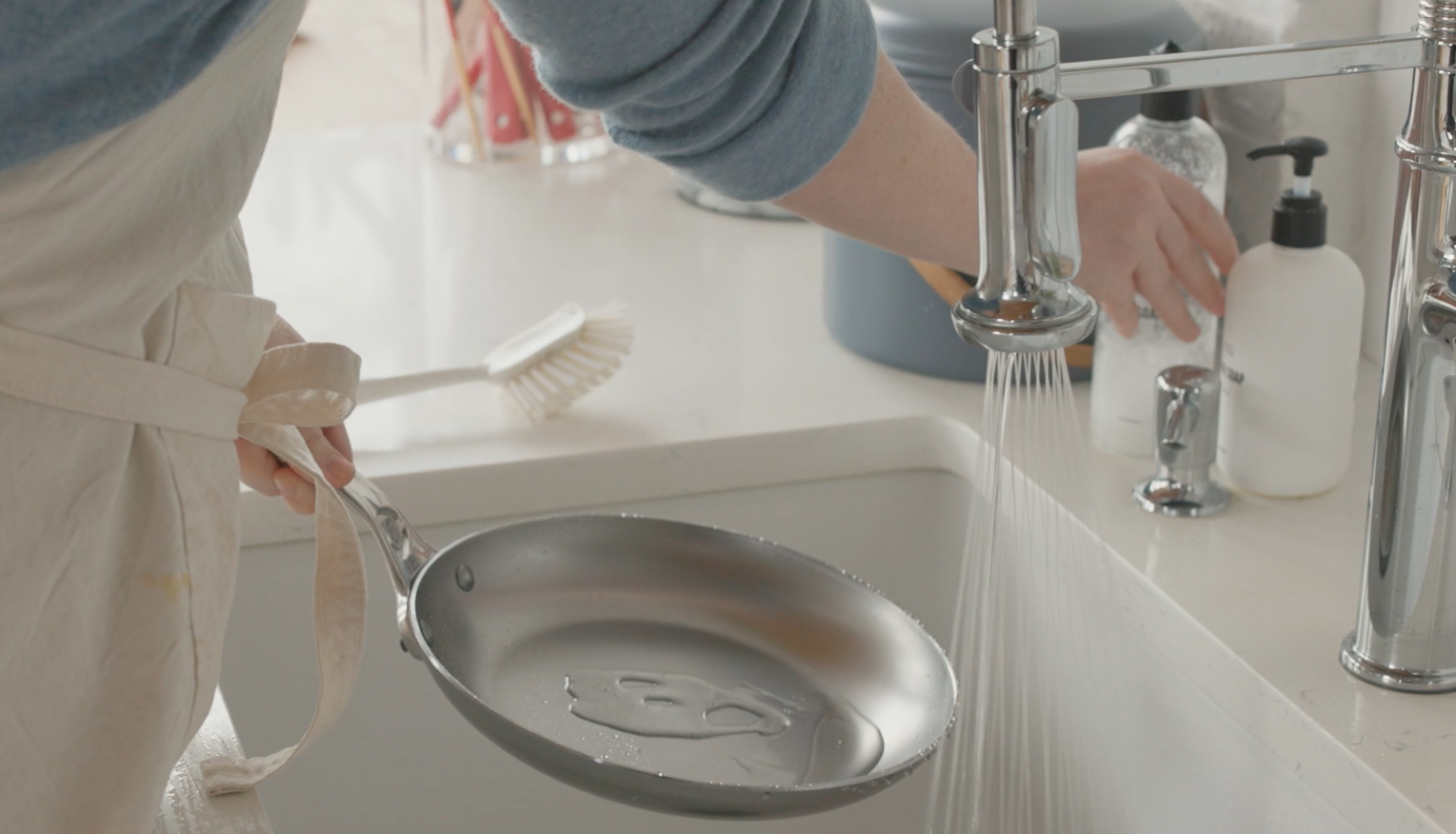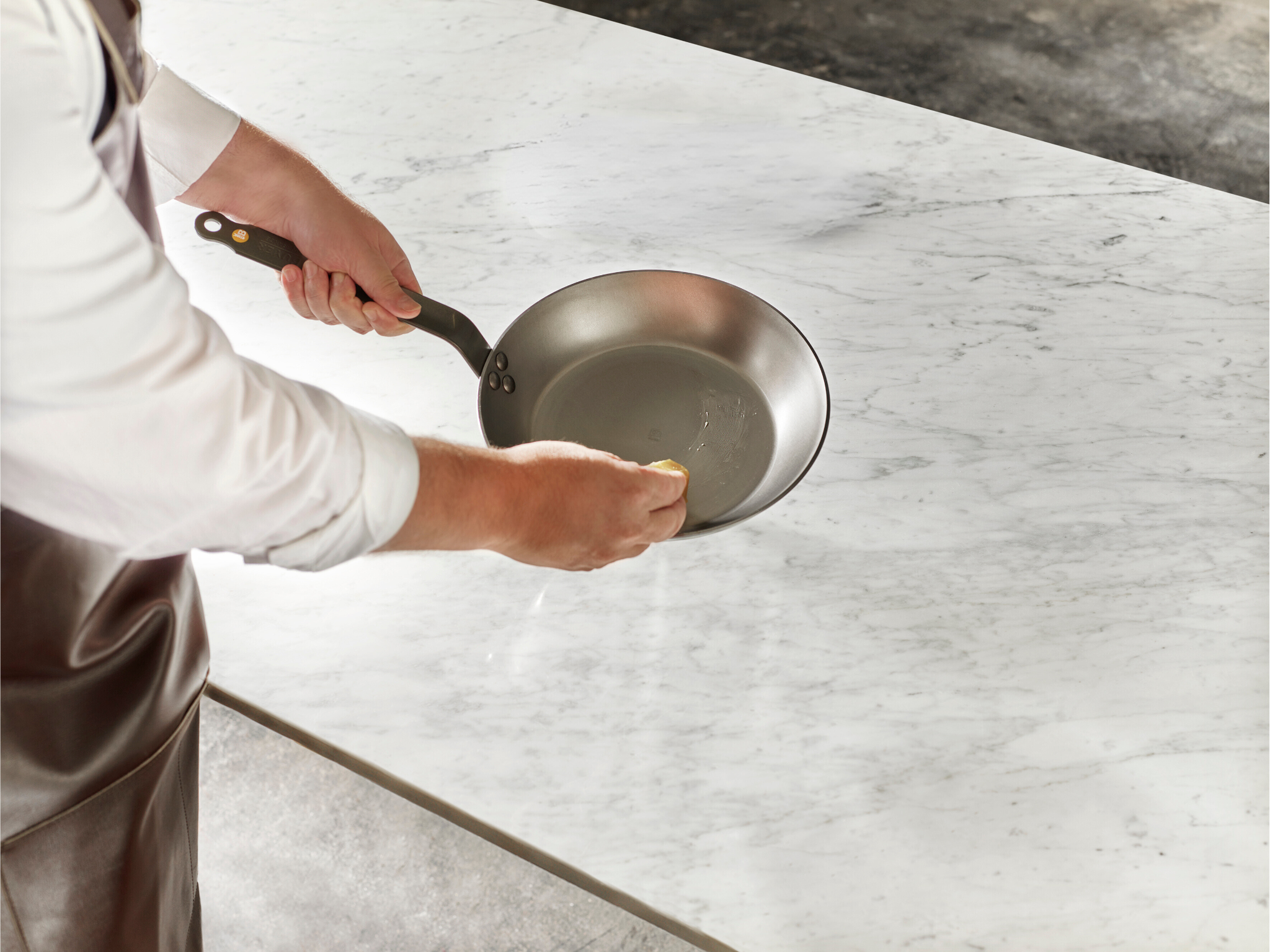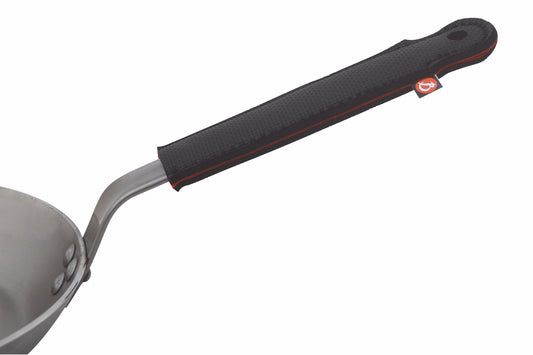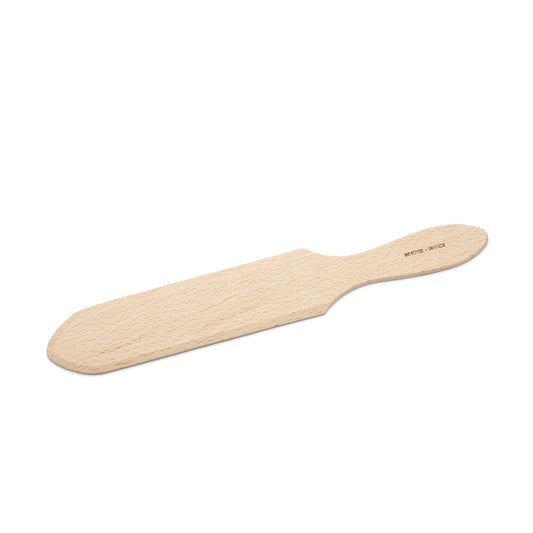How to Properly Season a Carbon Steel Pan
Learn how to season a carbon steel pan the right way. This step-by-step guide covers tools, techniques, and tips to create a nonstick, rust-resistant pan.
de Buyer

Key Takeaways
- Unlike cast iron, carbon steel’s smaller pores make it faster and easier to build up a slick, seasoned surface.
- Using too much oil during seasoning can lead to sticky buildup—apply only a thin, even layer for best results.
- Highly acidic foods or even boiling water can strip seasoning, but the pan can always be re-seasoned with ease.
- While oven seasoning offers more even coverage, stovetop seasoning is quicker and better suited for pans with coated handles.
Seasoning is a protective layer of polymerized oil that makes your carbon steel pan naturally non-stick and rust-resistant. With the right instructions and techniques, seasoning is simple, and the reward is long-lasting performance.
All de Buyer carbon steel pans come with a beeswax coating and need initial seasoning. Use this guide for step-by-step instructions and long-term care tips to keep your pan in excellent condition for years.
What Do You Need to Get Started?
You might be asking yourself, "Why is seasoning important?" You need to season the pan if you want to have a nonstick surface that evenly cooks food. And, seasoning will help protect the pan against corrosion and rust. While seasoning might sound like a complicated process, you only need a few ingredients to do the job.
Here are the tools you need to season:
- Carbon steel pan
- Paper towels or lint-free cloth
- High-smoke-point oil (e.g., flaxseed, grapeseed, sunflower)
- Oven or stovetop
- Tongs or heat-proof gloves
A thin layer of oil with a high smoke point will help fill in those tiny surface pores, getting your carbon steel pans on the right path to obtaining a good seasoning. As you continue to cook with the pan, all of the oils and fats from the food will fill in those pores and build up a layer of hardened oil. All of that oil will create a slick patina for your pans. Carbon steel pans have small and shallow pores, meaning you can get a solid layer of seasoning in no time.
You need the initial seasoning of oil, and then you will have a pan ready to go. As you cook with the pan, the seasoning will naturally build up and get better over time. After a few uses, that carbon steel pan will have a super slick surface.
If you already have cast-iron skillets, you know that achieving a slick surface can be a process. Some people have to season the pans three or four times to get a nice cooking surface. This is due to the deep pores of the cast iron, which require more time to develop a slick surface through seasoning. You will not have those issues while seasoning your carbon steel.
You will need to be cautious of certain foods. Highly acidic ingredients can dissolve the layer of seasoning. Even boiling water might remove your seasoning. But have no fear! You can always re-season the pan for a slick surface.
Step-by-Step: How to Season a Carbon Steel Pan
Now that you know why seasoning is critical, here's how to season those carbon steel pans. Think of the new pans as a clean slate. The initial seasoning is a crucial step to set it up for future use.
Thankfully, seasoning a carbon steel pan is not as complicated as seasoning a cast-iron skillet. If you are not happy with the result, you can always start over and re-season the pan.
1. Wash off the beeswax coating
de Buyer's carbon steel pans have a layer of French beeswax. While this wax is food-safe, you should wash it off the pan. Take hot, soapy water and rub off any residue. Once that’s done, you will want to dry the pan.
2. Dry thoroughly and heat to remove all moisture
Water will not harm the seasoning process, but the pan should be dried before placing it in the oven. Dry the pan with a paper towel, then place it on the stove to evaporate any remaining moisture and prevent rust.
3. Apply a very thin layer of oil
Next, you’ll heat the oven or prepare the stovetop, but first, you need to choose the right oil for the job. There are plenty of options to choose from, including soybean, avocado, peanut, and grapeseed oils. Use a neutral oil of your preference with a high smoke point.
No matter what you choose, heat the oven to slightly above the oil's smoke point. Many high-smoke-point oils fall in the range of 400 to 450°F.
Using a paper towel, apply a small amount of oil to the entire surface of the pan, including the inside, outside, and bottom. Wipe it until only a thin, even sheen remains; excessive oil can lead to sticky or uneven seasoning.
4. Heat the pan until it smokes (use stovetop or oven)
Both the stovetop and oven methods are effective and will protect your pan.
Oven Method
This is the preferred seasoning method for oven-safe pans simply because it is simple and foolproof.
- Preheat your oven to 475°F and place a foil-lined baking sheet on the lower rack to catch drips.
- Heat the oiled pan on the stovetop for 2 minutes to open the steel’s pores.
- Place the pan upside down on the center rack of the oven. Bake for 1 hour. Some smoke is normal—it’s a sign the seasoning is bonding to the pan.
Stovetop Method (for epoxy-coated handles)
Some de Buyer pans feature an epoxy-coated handle that is only oven-safe for short periods. For these pans, we recommend a simple stove-top seasoning.
- Place the oiled pan on the stove over medium-high heat.
- Heat until the oil starts to smoke, then turn off the heat.
- Let the pan cool before repeating if desired.
5. Let cool and repeat if desired
You are now ready to use your carbon steel pan. To continue building up the seasoning, repeat steps 1-2 a few times, then start cooking to allow the seasoning to develop naturally.
Keep in mind that your carbon steel pan will develop a patina over time. If you notice any discoloration, don't be alarmed. This is part of the process and means it is just on its way to becoming a well-seasoned pan.
Seasoning on the Stovetop vs. in the Oven
Both the stovetop and oven methods will successfully season your carbon steel pan, but each has its advantages. The method you choose may depend on your pan’s handle, the tools you have available, or the amount of time you have.
Oven seasoning provides even coverage across the entire pan (inside and out) and is easy to repeat for stronger results. However, it requires a fully oven-safe pan and takes more time (about one hour of baking, plus cool-down).
Meanwhile, stovetop seasoning is quick and efficient, making it great for small pans and those not fully oven-safe. Plus, it's convenient when you don’t want to heat up the oven. This method can result in uneven seasoning if not rotated or heated carefully, and may require more frequent touch-ups to the seasoning.
Regardless of which method you choose, your pan will benefit from either approach. Seasoning builds over time, so choose the process that best suits your kitchen and tools.
What Can You Expect From a Well-Seasoned Pan?
Your carbon steel pan will transform after seasoning. The light, even color will gradually darken to bronze-to-black tones as the patina forms. The pan surface will get darker over time.
Remember, your pan won’t be perfect after just one seasoning session, but it will improve with use. Eventually, even stick-prone foods like eggs will stop sticking and slide off your pan.
How Do You Maintain the Seasoning Over Time?
To maintain your new seasoning over time, simply follow these guidelines.
- Avoid soap or soaking.
- Clean with hot water and a soft sponge.
- Always dry and lightly oil after use.
- Cook with oil regularly to strengthen the layer.
- Avoid acidic foods until seasoning is well established.
Carbon Steel: A Patina Built to Last
These steps can help you achieve the perfect seasoned carbon steel pan. Once you have the initial seasoning, you can continue cooking with these pans to achieve the best results for your meals.
Looking for your next piece of cookware? Explore de Buyer’s carbon steel collection and experience cookware that improves with every meal.
Learn More
Recommended for You
-
MINERAL B PRO Carbon Steel Fry Pan
Regular price $100.00Regular priceUnit price / per$0.00Sale price $100.00 -
MINERAL B Classic Carbon Steel Fry Pan
Regular price $65.00Regular priceUnit price / per -
MINERAL B Carbon Steel Omelette Pan
Regular price $75.00Regular priceUnit price / per -
MINERAL B PRO Carbon Steel Omelette Pan
Regular price $120.00Regular priceUnit price / per -
Protective Sleeve for Pan Handle
Regular price $9.95Regular priceUnit price / per -
MINERAL B Carbon Steel Crepe & Tortilla Pan
Regular price $65.00Regular priceUnit price / per -
Blue Carbon Steel Fry Pan
Regular price $50.00Regular priceUnit price / per -
Blue Carbon Steel Crepe & Tortilla Pan
Regular price $25.00Regular priceUnit price / per -
MINERAL B Carbon Steel Country Fry Pan
Regular price $110.00Regular priceUnit price / per -
MINERAL B Carbon Steel Egg & Pancake Pan
Regular price $40.00Regular priceUnit price / per -
Blue Carbon Steel Rectangular Baking Sheet
Regular price $40.00Regular priceUnit price / per -
B BOIS Crepe Spatula
Regular price $8.00Regular priceUnit price / per

